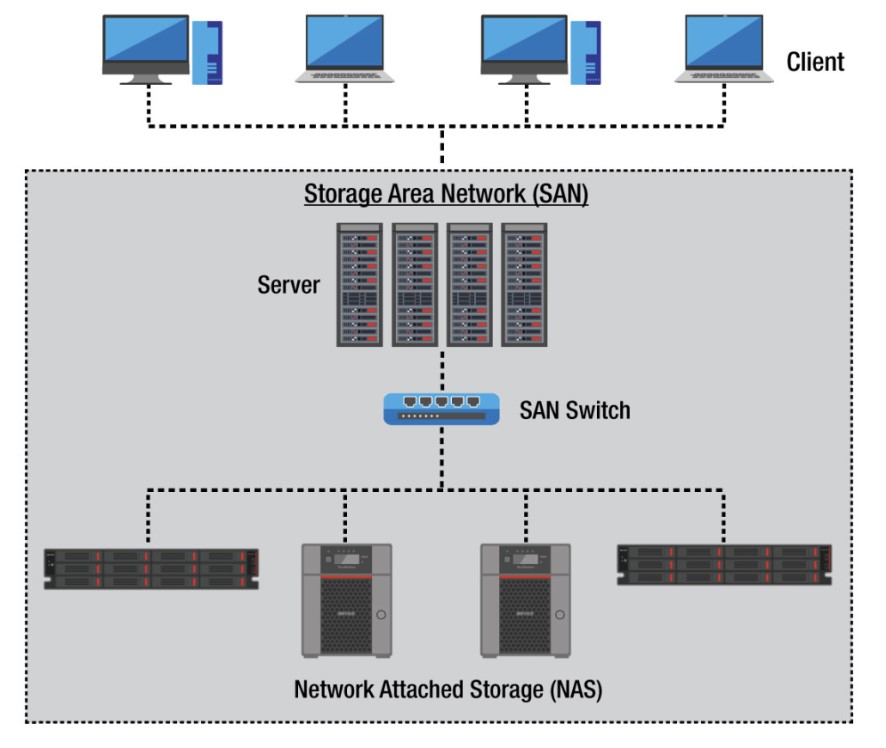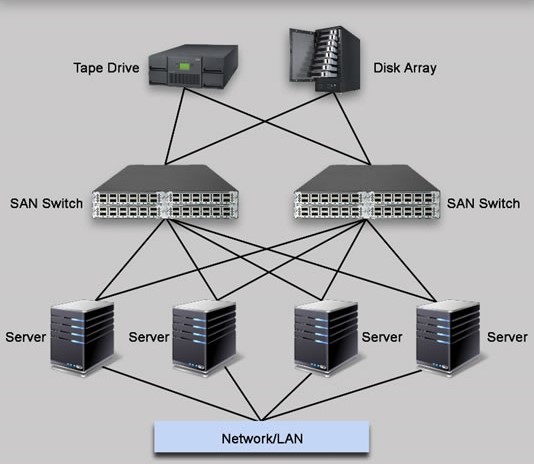Storage Area Network (SAN)
The Purpose of SAN
The primary purpose of a SAN is to improve storage efficiency, availability, and performance. It achieves this by abstracting storage devices from the servers, creating a dedicated network for data transfers, and providing a platform for centralized storage management.

Key Features Making SAN Indispensable:
- Scalability: SANs allow seamless addition or removal of storage devices, supporting uninterrupted server operation and application running.
- Robust Security: Featuring virtual SANs for restricted data access and comprehensive security protocols to safeguard against cyber threats.
- Optimized Disk Use: Centralized networks enhance control and disk utilization, with dynamic tiering for efficient data movement.
- Reliable Disaster Recovery: Equipped with backup and recovery systems to safeguard data, ensuring business continuity.
- Minimal Downtime: SANs maintain industry-standard uptime, reducing resets or stops due to performance issues.
- Rapid Data Transfers: Utilizing fiber optic cables for speeds up to 4 Gbps, outpacing NAS and DAS systems.
- Data Deduplication: Identifies and removes duplicate data blocks, optimizing storage space.
- Centralized Backup: Real-time backup systems minimize downtime, ensuring network continuity.
- Dynamic Failover Protection: Traffic rerouting to stable networks during server issues or maintenance.
- Thin Provisioning: Virtualizes storage disks, allowing allocation beyond physical capacity for space efficiency.
- Accessible Applications: Facilitates remote application access, not limited by geographic locations.
- Streamlined Data Management: Automates tasks and provides block-level data access for restricted account usage.
SAN Architecture
The basic architecture of a SAN consists of the following components:
- Servers: The servers that access the storage devices on the SAN.
- Storage devices: The disks, tape libraries, and other storage devices that are connected to the SAN.
- Network infrastructure: The switches and cables that connect the servers and storage devices.
- SAN management software: The software that manages the SAN, such as provisioning storage, monitoring performance, and troubleshooting problems.

The servers and storage devices in a SAN are connected to a high-speed network, called the SAN fabric. The SAN fabric is made up of switches that are interconnected to form a network topology.
Key Elements of SAN Architecture: Servers, Storage, and Network
There are three essential components of SAN: servers, storage, and network infrastructure. These components are divided into vital elements such as node ports, storage arrays, cabling, interconnecting devices, and SAN management software.
Brands like Dell EMC, Cisco, and IBM are at the forefront, offering advanced SAN solutions that redefine data storage efficiency and security, marking a new era in organizational data management.
Top 10 Differences between SAN and NAS

Transform Your Network with HPE SAN Solutions
Experience seamless connectivity with HPE's Storage Area Network (SAN) solutions, which offer a robust portfolio of fabric products validated by HPE's Single Point of Connectivity Knowledge (SPOCK). Enhance your network's reliability and performance with comprehensive support that ensures your infrastructure meets the highest standards of efficiency and security. Read more in eBrochure
SAN technology, Game-changer for Business
A Storage Area Network (SAN) is a specialized network designed to consolidate block-level data storage, providing PCs and servers with a shared storage pool via devices connected to disks, tapes, etc. This configuration allows the operating system (OS) to treat the SAN as if it were directly attached storage. Typically connected through Fiber Channel (FC) networks, SAN's main role is to facilitate data transfers between servers and storage devices while enabling the sharing of data across systems.
As organizational data grows rapidly, the need for efficient, secure, and scalable storage solutions becomes critical. SAN technology meets these needs by offering a flexible and resilient architecture that integrates seamlessly with organizational processes, ensuring data is handled, optimized, and protected effectively. It supports just-in-time information delivery without compromising security or application performance.
Cisco SAN Analytics
Cisco SAN Analytics is the industry’s first and only solution to provide at-the-scale visibility into NVMe and SCSI traffic in real-time. Learn more about Cisco Storage Networking:
Cisco MDS 9000 SAN Directors and Fibre Channel Switches Overview
This is a detailed Overview of the current MDS SAN portfolio. Customers need this data to understand what all switches and director chassis are currently in support.
Increase Availability & Resilience
Large enterprises that need fast access to large volumes of data, such as e-commerce websites with vast databases, require efficient, secure, and scalable data storage solutions. SAN technology is an excellent option for business-critical applications that need high throughput and low latency. SANs are designed to eliminate individual points of failure, thereby increasing their availability and resilience.
- Data Security and Protection: Our backup solutions offer robust security measures, including end-to-end encryption, ensuring that your data is protected from unauthorized access, corruption, or theft. This level of security is crucial for maintaining the integrity and confidentiality of sensitive business data.
- Disaster recovery: In the event of a system failure, cyber-attack, or natural disaster, having a reliable backup system in place ensures that your critical data can be quickly restored. This minimizes downtime and helps maintain business continuity, protecting you from significant operational and financial impacts.
- Compliance and Regulatory Adherence: Many industries are governed by strict data protection and privacy regulations. Our backup solutions help you comply with these legal requirements, avoiding potential legal and financial penalties associated with non-compliance.
- Scalability: As your business grows, so does your data. Our backup solutions are designed to scale with your business, offering flexible storage options and customizable features to meet your evolving needs. This scalability ensures that you are always equipped with a backup solution that fits your business size and complexity.
- Ease of Management and Monitoring: With user-friendly interfaces and automated processes, our backup solutions simplify the task of managing and monitoring backups. This not only saves time and resources but also provides peace of mind knowing that your data is continuously being backed up without the need for constant manual intervention.
Types of SAN
Storage Area Networks have different types to meet various needs. Some are built for speed, ideal for super-fast applications like databases, while others are more budget-friendly, great for cost-conscious projects. There are also SANs focused on security, ensuring your data stays safe, and even SANs designed to adapt to future technologies. In the following we’ll explore these different types of SANs and help you understand which one might be the best fit for your specific requirements.
- Fibre Channel SANs: Fibre Channel is a high-speed, lossless networking technology that is specifically designed for SANs. Fibre Channel SANs offer the best performance and scalability, but they are also the most expensive.
- Ethernet SANs: Ethernet SANs use standard Ethernet networking technology. Ethernet SANs are less expensive than fibre channel SANs, but do not offer the same level of performance and scalability.
- iSCSI: iSCSI is a networking protocol that allows SCSI commands to be sent over an IP network. iSCSI SANs are less expensive than Fibre Channel SANs, but they do not offer the same level of performance and scalability.
- FCoE: Fibre Channel over Ethernet (FCoE) is a storage networking technology that encapsulates Fibre Channel frames over Ethernet networks. This allows Fibre Channel to use 10 Gigabit Ethernet networks (or higher speeds) while preserving the Fibre Channel protocol.FCoE is a good choice for organizations that are looking to save money, simplify management, or increase scalability. It is particularly well-suited for small and medium businesses that do not need the high performance of a traditional Fibre Channel SAN.
Where is SAN preferably used?
SANs find their ideal use cases in various scenarios, including:
SANs are commonly deployed in large data centers where multiple servers need access to centralized and shared storage. This centralised approach simplifies management and improves resource utilisation.
SANs are a staple in virtualization environments like VMware and Hyper-V. They provide the necessary storage resources for virtual machines while maintaining high performance and availability.
Databases, with their demanding I/O requirements, benefit greatly from SANs. The high-speed, low-latency connectivity of SANs ensures that database operations are efficient and responsive.
SANs are often used for backup and disaster recovery solutions. The ability to replicate data across geographically distant locations ensures data integrity and business continuity.
The best SAN type for an organization will depend on its specific needs and requirements. Organisations that need the highest level of performance and scalability should consider a fibre-channel SAN. Organisations looking for a more cost-effective solution may want to consider an Ethernet SAN or an iSCSI SAN.
Seeking the Ideal Storage Area Network Solution?
As digital landscapes evolve and data demands increase, the necessity for robust storage solutions becomes paramount. A Storage Area Network (SAN) is crucial for businesses dealing with large-scale data transactions, providing dedicated high-speed networks that connect your servers to their storage devices. This strategic setup not only enhances data transfer speeds but also increases storage capacity and reliability, ensuring that critical data is always accessible when needed. At ServerDirect, we are dedicated to helping you find the SAN that perfectly aligns with your operational needs and objectives, offering tailor-made solutions that ensure efficiency, scalability, and security.




Schrijf in voor onze Nieuwsbrief
Hebt u vragen of hulp nodig? Wij helpen u graag.
15+ jaar ervaring • Preferred partner van Dell, HPE & Supermicro en meer • Advies op maat binnen 1 werkdag • Snelle levering & installatie • Wereldwijde 24/7 onsite support • Laagste prijsgarantie
